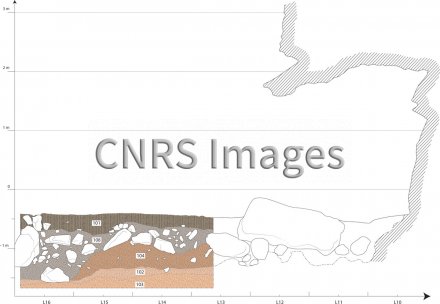Production year
2017

© Nicolas NAUDINOT/ Camille BOURDIER / CEPAM / TRACES / PLOS ONE / CNRS Images
20170070_0001
Cross-section of the rock shelter at the Rocher de l’Impératrice site in Plougastel-Daoulas, Finistère. This shelter, where digging began in 2013, was mainly occupied at the start of the Azilian, around 14,500 years ago. It was used for short periods by hunters visiting the valley that is now under the sea. The most recent stratum, 101, is made up of colluvium and reworked deposits. Layer 108 is made up of a scree of quartzite rock in colluvium, while layer 102, containing Azilian artefacts, is a loessial silt in a secondary context with many cryoclastic angular boulders. The Azilian developed during the Late Glacial period following the Ice Age, which was characterised by major climate disruption. At that time, the sea level was 90 metres lower. In this shelter used for hunting activities in the valley, flint tools have been found as well as engraved schist tablets. These remains constitute a major archaeological discovery for a little-documented period of prehistory. (Naudinot N, Bourdier C, Laforge M, Paris C, Bellot-Gurlet L, Beyries S, et al. (2017) Divergence in the evolution of Paleolithic symbolic and technological systems: The shining bull and engraved tablets of Rocher de l'Impératrice. PLoS ONE 12(3): e0173037.)
The use of media visible on the CNRS Images Platform can be granted on request. Any reproduction or representation is forbidden without prior authorization from CNRS Images (except for resources under Creative Commons license).
No modification of an image may be made without the prior consent of CNRS Images.
No use of an image for advertising purposes or distribution to a third party may be made without the prior agreement of CNRS Images.
For more information, please consult our general conditions
2017
Our work is guided by the way scientists question the world around them and we translate their research into images to help people to understand the world better and to awaken their curiosity and wonderment.